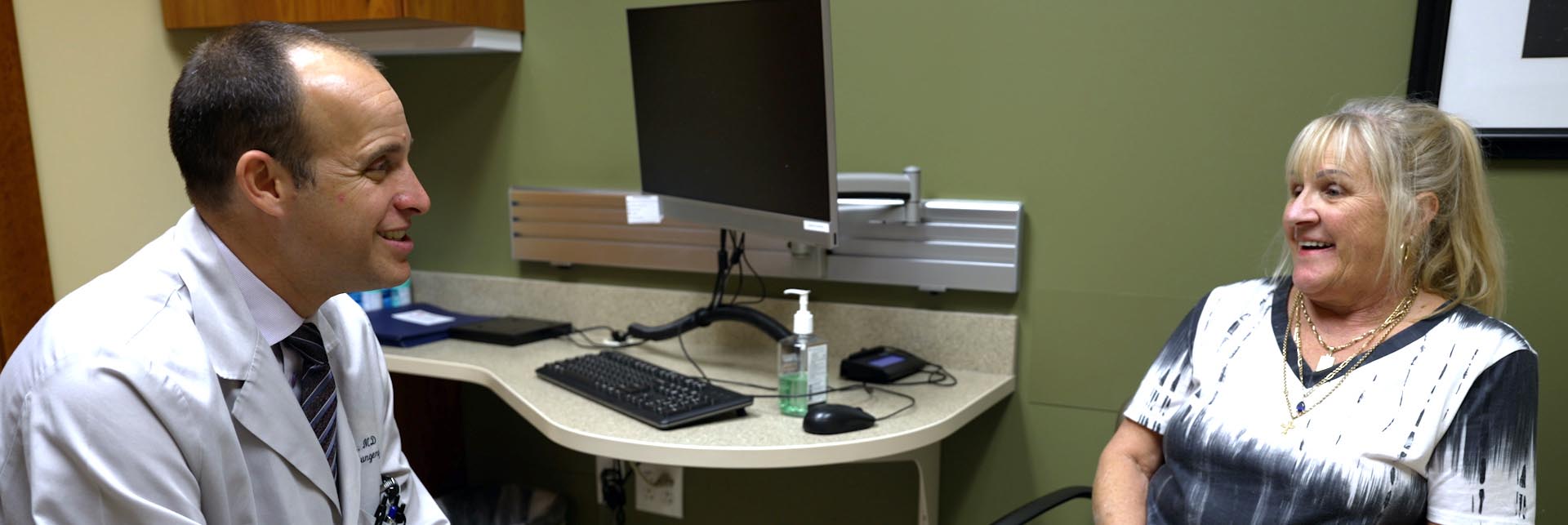Limb saving program helps patients with diabetes avoid amputation
March 17, 2024
Categories: Diabetes, Endocrinology, Orthopaedics
Tags: Endocrinology, Loyola Medicine, Orthopaedics, Surgical Services
MAYWOOD, IL - According to the American Diabetes Association, 154,000 people with diabetes undergo amputation each year. Over time, high blood sugar can lead to complications that raise the chance of a lower limb amputation and those who have an amputation face a worse chance of five-year survival than someone with coronary artery disease, breast cancer or colon cancer. That's why, after spending more than three decades managing her diabetes, Pam Mirabile was alarmed by swelling in her foot. She visited Loyola Medicine podiatric surgeon Katherine Dux, DPM, who diagnosed her with Charcot foot, a rare complication of diabetes. If left untreated, Charcot foot, also known as diabetic foot, can lead to amputation. Dr. Dux successfully managed Pam's condition without surgery for five years by using a series of casts. Unfortunately, Pam developed a recurrent Charcot flare that resulted in progressive deformity which necessitated surgical reconstruction. She was referred to Adam Schiff, MD, an orthopedic surgeon at Loyola Medicine specializing in limb salvage.
Charcot foot begins with nerve damage, which can destroy the bone. "The nerves affect the quality of the bone and seemingly small injuries or no injury at all can cause extensive damage," said Schiff. "Essentially, bones will fracture or dislocate and leave the foot in a deformed position. That has huge implications when it comes to bearing weight. If their foot is not well aligned and flat on the ground, it increases the risk for ulcers and other complications." Early treatment and intervention are crucial in patients with Charcot foot. Pam's foot had developed an ulceration and part of the bone was breaking through the wound, which put her at high risk for amputation. As the owner of a home health care business, Pam was frightened at the thought of losing her foot. "You have all these horrible visions going through your mind about how it's going to affect your future."
Dr. Schiff recommended surgery involving foot and ankle reconstruction and lengthening her Achilles tendon. After surgery in February 2023, Pam's limb was held in place with an external fixator, a device that keeps bones stabilized. Schiff said, "We can't put a lot of metal on the inside because it can cause or worsen an infection. For Pam, we were able to put metal on the outside using rings and metal spokes like the spokes on a bicycle. It lets us do pretty extensive surgery without the risk of long term infection."
Pam spent three months in the fixator while her bones healed and relied on a knee scooter to get around. After it was removed, she progressed quickly to a boot and finally gym shoes. Pam says it's been a huge success, "I'm really happy and it looks like a normal foot again." This January she visited Hawaii and climbed a mountain at Waimea Canyon. She credits the entire team at Loyola with saving her foot. "They were just fabulous. Dr. Schiff and his team have been a great support system for me. I don't know what I would have done without their confidence in me and their abilities."
The team at Loyola Medicine's limb-saving program takes an integrated approach, combining the expertise of orthopaedic surgeons, podiatrists, endocrinologists and other specialists. Dr. Schiff says it starts with preventive care. "It's really important to get patients plugged into a system that can provide a full continuum of care. We're able to prevent complications from diabetes. And if they happen, we know how to solve them."
For more about Pam and Charcot foot, check out this video.
About Loyola Medicine
Loyola Medicine, a member of Trinity Health, is a nationally ranked academic, quaternary care system based in Chicago's western suburbs. The three-hospital system includes Loyola University Medical Center (LUMC), Gottlieb Memorial Hospital, MacNeal Hospital, as well as convenient locations offering primary care, specialty care and immediate care services from nearly 2,000 physicians throughout Cook, Will and DuPage counties. LUMC is a 547-licensed-bed hospital in Maywood that includes the William G. and Mary A. Ryan Center for Heart & Vascular Medicine, the Cardinal Bernardin Cancer Center, the John L. Keeley, MD, Emergency Department, a Level 1 trauma center, Illinois's largest burn center, the Nancy W. Knowles Orthopaedic Institute, a certified comprehensive stroke center, transplant center and a children’s hospital. Having delivered compassionate care for over 50 years, Loyola also trains the next generation of caregivers through its academic affiliation with Loyola University Chicago’s Stritch School of Medicine and Marcella Niehoff School of Nursing.
Established in 1961, Gottlieb Memorial Hospital is a 235-licensed-bed community hospital in Melrose Park that includes the Judd A. Weinberg Emergency Department, the Loyola Center for Metabolic Surgery and Bariatric Care, Loyola Cancer Care & Research at the Marjorie G. Weinberg Cancer Center, acute rehabilitation, a transitional care center, childcare center and fitness center. Founded in 1919, MacNeal Hospital is a 349-licensed-bed teaching hospital in Berwyn with advanced medical, surgical and psychiatric services and a 68-bed behavioral health program.
For more information, visit loyolamedicine.org. You can also follow Loyola Medicine on LinkedIn, Facebook, Instagram or X (formerly known as Twitter).
About Trinity Health
Trinity Health is one of the largest not-for-profit, faith-based health care systems in the nation. It is a family of 127,000 colleagues and more than 38,300 physicians and clinicians caring for diverse communities across 26 states. Nationally recognized for care and experience, the Trinity Health system includes 93 hospitals, 107 continuing care locations, the second largest PACE program in the country, 142 urgent care locations and many other health and well-being services. In fiscal year 2024, the Livonia, Michigan-based health system invested $1.3 billion in its communities in the form of charity care and other community benefit programs. For more information, visit us at www.trinity-health.org, or follow us on LinkedIn, Facebook, and X (formerly known as Twitter).
